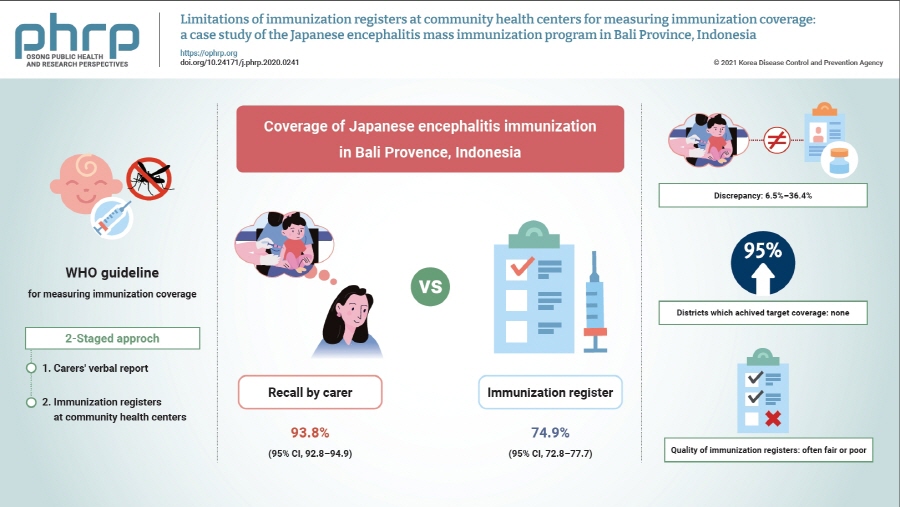Search
- Page Path
- HOME > Search
- Limitations of immunization registers at community health centers for measuring immunization coverage: a case study of the Japanese encephalitis mass immunization program in Bali Province, Indonesia
- Anak A. S. Sawitri, Putu C. D. Yuliyatni, Made D. Ariawan, Komang A. Kartika Sari, Raka Susanti, I Nyoman Sutarsa
- Osong Public Health Res Perspect. 2021;12(3):158-168. Published online June 2, 2021
- DOI: https://doi.org/10.24171/j.phrp.2020.0241
- 6,518 View
- 132 Download
- 1 Web of Science
- 1 Crossref
-
 Graphical Abstract
Graphical Abstract
 Abstract
Abstract
 PDF
PDF 
- Objectives
The aim of this study was to compare the coverage of Japanese encephalitis (JE) immunization obtained from a recall survey and immunization registers at community health centers (CHCs) in Bali Province, Indonesia.
Methods
A population-based survey was conducted, and random 2-staged selection of clusters of sub-villages was performed. The sample consisted of households with children aged 9 months to 15 years old. Interviews were carried out with carers to recall JE immunization status. The recall immunization status was considered valid when name, date, and confirmation of immunization were available in an immunization register at a CHC. Descriptive analysis was performed. The completeness of the information within immunization registers at CHCs was assessed.
Results
The coverage of JE immunization obtained from the recall survey was 93.8% (95% confidence interval [CI], 92.8–94.9). It decreased to 74.9% (95% CI, 72.8–77.2) after being validated against immunization registers. The recall coverage of JE immunization was significantly higher than immunization register data suggested. This discrepancy varied from 6.5% to 36.4% across 6 districts; however, none of these districts achieved the recommended target coverage of 95%. The quality of immunization registers varied across CHCs.
Conclusion
The use of an immunization register may result in underestimating the true coverage of vaccination programs, and its utilization for measuring immunization coverage requires further consideration. -
Citations
Citations to this article as recorded by- Japanese encephalitis in Bali, Indonesia: ecological and socio-cultural perspectives
I Made Kardena, Anak Agung Ayu Mirah Adi, Nyoman Mantik Astawa, Mark O’Dea, Michael Laurence, Shafi Sahibzada, Mieghan Bruce
International Journal of Veterinary Science and Me.2021; 9(1): 31. CrossRef
- Japanese encephalitis in Bali, Indonesia: ecological and socio-cultural perspectives
- Nutritional Status of Indonesian Children in Low-Income Households with Fathers that Smoke
- Maria Wijaya-Erhardt
- Osong Public Health Res Perspect. 2019;10(2):64-71. Published online April 30, 2019
- DOI: https://doi.org/10.24171/j.phrp.2019.10.2.04
- 21,760 View
- 210 Download
- 6 Crossref
-
 Abstract
Abstract
 PDF
PDF Objectives This study compared the nutritional status of children in low-income households in Indonesia whose fathers were either cigarette smokers or non-smokers.
Methods A cross sectional study of 482 children aged 2–6 years was conducted, stratified by whether the fathers were non-smoking (
n = 138) or smoking (n = 340). Mothers and smoking fathers were interviewed about socioeconomic status and cigarette expenditure, respectively. The nutritional status of children was defined by weight-for-age, height-for-age and weight-for-height.Results Both groups had similar income. Households with a father that smoked, spent 16.6% of their income on cigarettes. Children whose fathers did not smoke had higher height-for-age (−1.99 vs. −2.25 Z-score,
p = 0.02) than children whose fathers smoked. Weight-for-age in children with fathers that did not smoke was greater (−1.49 vs. −1.64 Z-score) but not statistically significantly different to those children with fathers that smoked, nor was child weight-for-height (−0.46 vs. −0.45 Z-score). The prevalence of stunted growth was higher in the children with a father that smoked compared with those that had a father did not smoke (62.2 vs. 49.6%,p = 0.07, respectively). There were 28.3% of children underweight in homes where the fathers did not smoke, and 35.6% in households where the father smoked (p = 0.11). Wasting was observed in 4.4% children where fathers did not smoke and 4.7% where fathers did smoke.Conclusion With similar income constraints, the degree of height growth faltering was less in children whose fathers did not smoke, compared to those whose fathers did smoke.
-
Citations
Citations to this article as recorded by- Crowding-out effect of tobacco consumption in Indonesia
Arya Swarnata, Fariza Zahra Kamilah, I Dewa Gede Karma Wisana, Yurdhina Meilissa, Gita Kusnadi
Tobacco Control.2024; : tc-2022-057843. CrossRef - Do parental Smoking Behaviors Affect Children's Thinness, Stunting, and Overweight Status in Indonesia? Evidence from a Large-Scale Longitudinal Survey
Adrianna Bella, Teguh Dartanto, Dimitri Swasthika Nurshadrina, Gita Kusnadi, Faizal Rahmanto Moeis, Renny Nurhasana, Aryana Satrya, Hasbullah Thabrany
Journal of Family and Economic Issues.2023; 44(3): 714. CrossRef - Sustainable Iodized Salt Fortification Reduces the Risk of Underweight Among Under-Five Children
Nadiyah, Idrus Jus'at, Devi Angeliana Kusumaningtiar, Anugrah Novianti
Journal of Law and Sustainable Development.2023; 11(9): e1207. CrossRef - Developmental trajectories of body mass index since childhood and health-related quality of life in young adulthood: Tehran Lipid and Glucose Study
Parnian Parvin, Parisa Amiri, Mohammad Masih Mansouri-Tehrani, Leila Cheraghi, Amirali Zareie Shab-khaneh, Fereidoun Azizi
Quality of Life Research.2022; 31(7): 2093. CrossRef - Cigarette smoke exposure and increased risks of stunting among under-five children
Dyah Dwi Astuti, Tri Widyastuti Handayani, Duwi Pudji Astuti
Clinical Epidemiology and Global Health.2020; 8(3): 943. CrossRef - The association between secondhand smoke exposure and
growth outcomes of children: A systematic literature review
Siti Nadhiroh, Kusharisupeni Djokosujono, Diah Mulyawati Utari
Tobacco Induced Diseases.2020;[Epub] CrossRef
- Crowding-out effect of tobacco consumption in Indonesia



 First
First Prev
Prev


